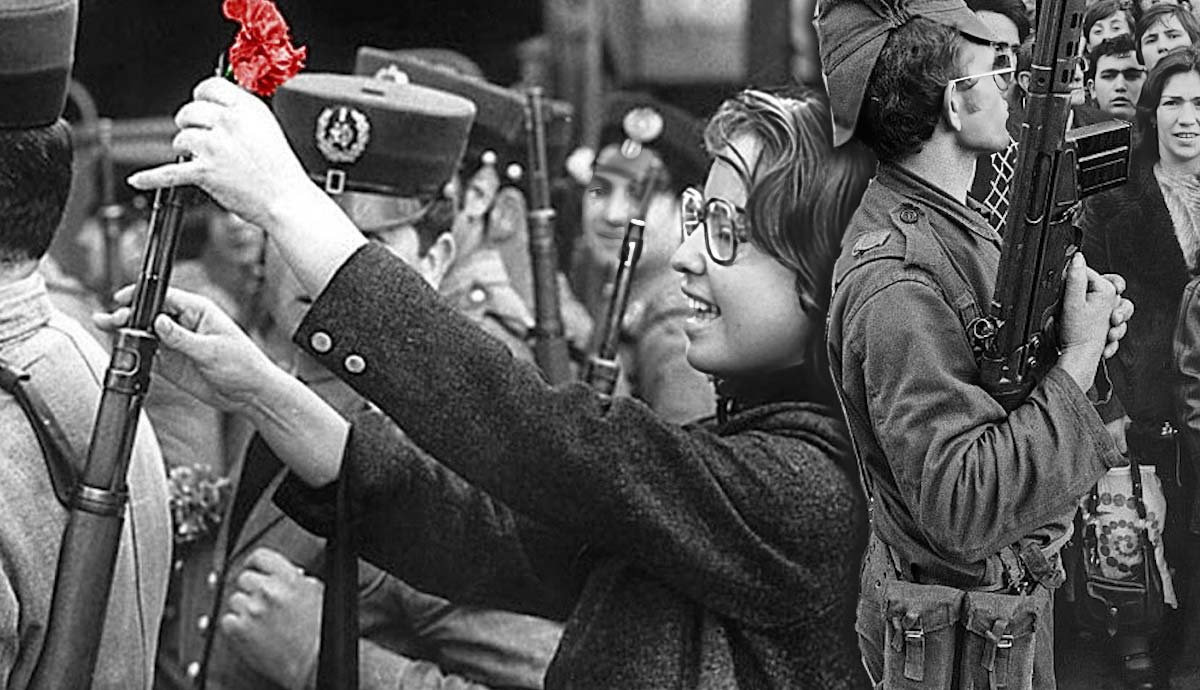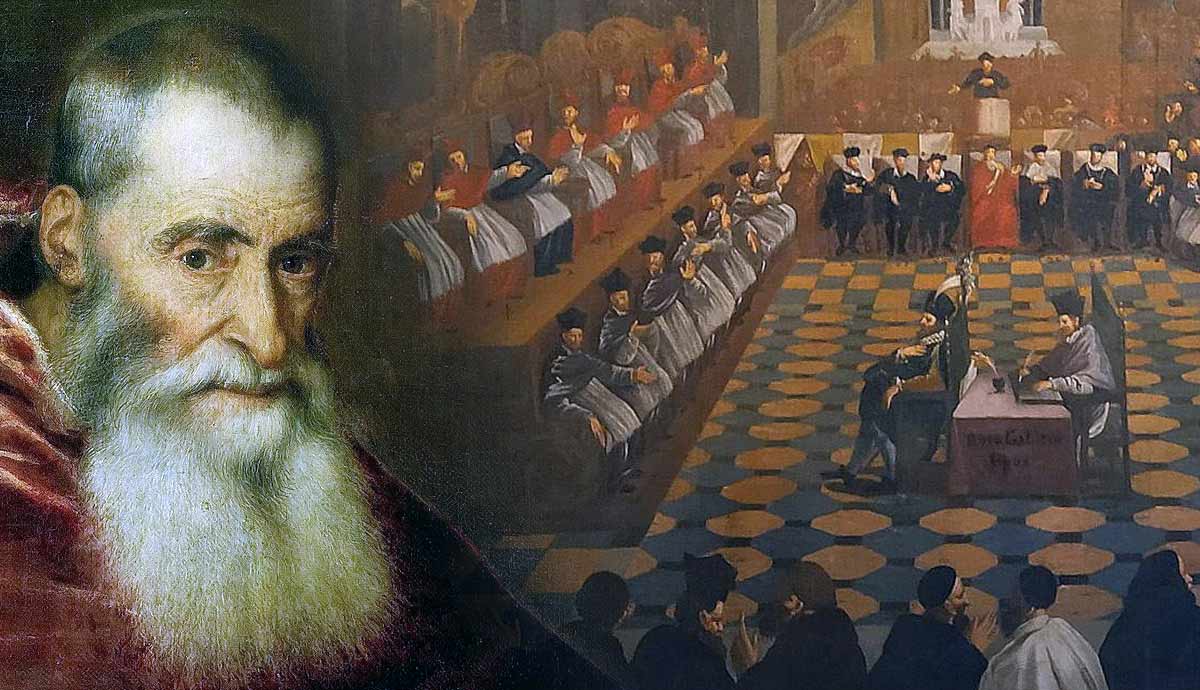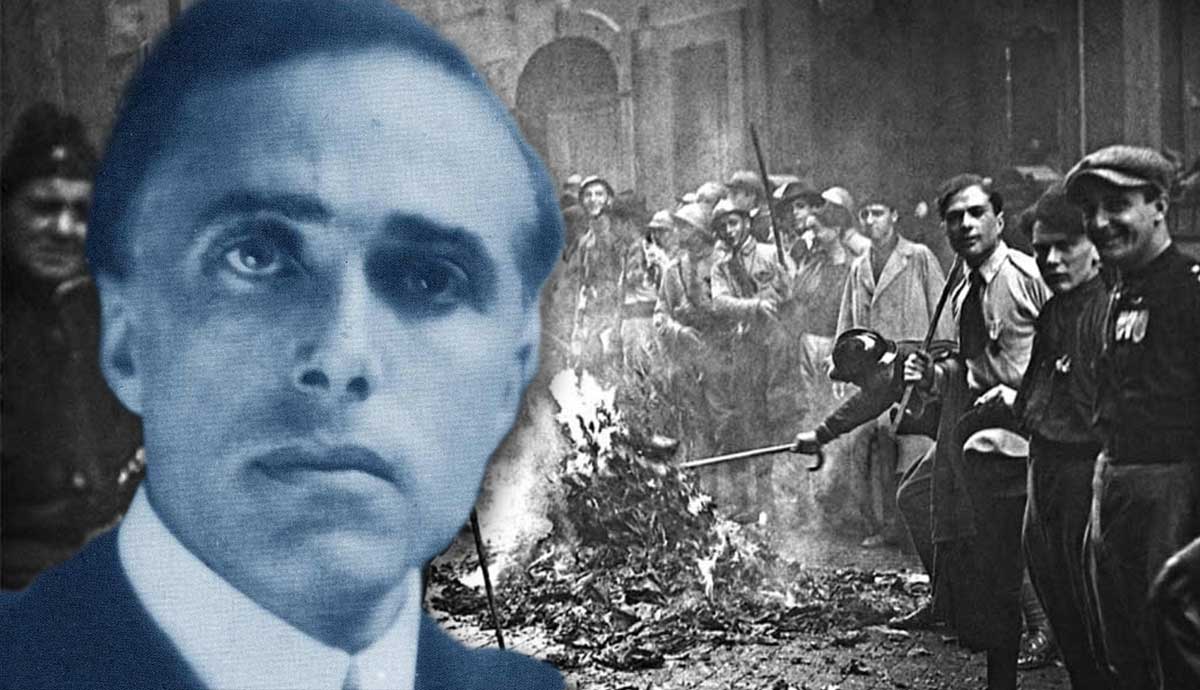
On the early morning of April 25, 1974, recalled Phil Mailer, a Dubliner working in Lisbon, “the following radio announcement stuns hundreds of thousands of Portuguese into a realization that a new phase in their history has begun: The Portuguese Armed Forces appeal to all the inhabitants of Lisbon to stay at home and remain as calm as possible.”
It was the beginning of the so-called Carnation Revolution, a coup d’état led by sectors of the military that toppled the Estado Novo (New State), Europe’s longest-living authoritarian regime. Despite the army’s initial recommendation, the residents of Lisbon gathered in the streets to cheer the rebels, expressing their hope for freedom after about 40 years of dictatorship.
The Estado Novo & The Carnation Revolution

In 1974, the Portuguese armed forces, dissatisfied with the regime’s handling of the colonial wars in Africa, conspired to put an end to the dictatorship they had helped form some 40 years before. Indeed, on May 28, 1926, a military coup d’état toppled the unstable parliamentary republic born in 1910. After the sudden regime change, General António Óscar de Fragoso Carmona headed the initial provisional government, commonly known as Ditadura Nacional (National Dictatorship). Then, in 1928, faced with the threat of a financial crisis, the army leader appointed António de Oliveira Salazar as Minister of Finance. At the time, Salazar was a professor of Economics and Finance at the University of Coimbra. Four years after his first appointment, he became prime minister.
In the years following his direct involvement in Portugal’s politics, Salazar began a process that would transform Portugal into an authoritarian regime. In 1930, for example, he founded the União Nacional (National Union), an umbrella organization that became the only legal political party in the country. In 1933, a new constitution officially turned the Ditadura Nacional into the Estado Novo, an autocratic corporatist state.
The constitutional charter created two representative bodies. The legislative role of the first one, known as the National Assembly, was limited to activities that did not rely on public spending. Only members of the National Union could join the assembly. On the other hand, the so-called Corporative Chamber was formed by representatives of the country’s official professional groups and workers’ organizations, established after disbanding the previous trade unions.

The 1933 document also introduced changes regarding the offices of the president and the prime minister. Directly elected for a seven-year term, the president was granted a vast array of powers, including the faculty of appointing the prime minister. However, Salazar, who remained the Prime Minister of Portugal until 1968, was the de facto head of the government.
Under Salazar’s rule, the Estado Novo curtailed civil rights and liberties. The regular use of state censorship limited the freedom of speech, silencing the opposition. The Secret Police aided the regime in implementing its directives while imprisoning and killing the political opponents. Salazar, who had planned to become a priest in his youth, strengthened the relationship between the state and the Catholic Church, restoring Catholicism as the official state religion. Deus, Pátria e Família (God, Fatherland, and Family), declared a motto of the Estado Novo.
While the Portuguese regime supported Francisco Franco’s fascist forces during the Spanish Civil War, the government opted for neutrality after the outbreak of World War II. In 1949, Portugal was one of the founding members of the North Atlantic Treaty Organization (NATO). In the postwar years, Salazar, a staunch supporter of Portugal’s colonial empire, firmly rejected the process of decolonization that began to restore independence to the overseas territorial possessions of the Western powers. The costly colonial wars, however, began to erode the regime’s consensus among the forces stationed in the overseas territories and the Portuguese at home.
The Estado Novo & Colonialism

The myth of Portugal’s colonial empire was a crucial element of the propaganda discourse promoted by the Estado Novo. Focusing on the celebration of the so-called Age of Discoveries, when Portuguese sailors traveled the world to establish commercial routes to the East, Salazar’s regime created a historical narrative and a national identity around the alleged “civilizing crusade” of Portugal. To this end, the Estado Novo claimed to embody the historical imperial vocation at the heart of the Iberian country’s essence. Thus, the colonial rhetoric and the ideology legitimizing the regime became inextricably intertwined.
In 1930, as Minister of the Colonies, Salazar promulgated the Colonial Act. “It is of the organic essence of the Portuguese Nation to perform the historical function of owning and colonizing overseas domains and civilizing the indigenous populations,” claimed Article 2 of the document. The Colonial Act, later incorporated into the 1933 constitution, marked the beginning of a new colonial policy, which sought to centralize control over all territorial possessions, highlighting their dependence on the metropolis.

The crucial role of the colonial discourse within the regime’s ideology and propaganda efforts led Salazar to oppose the process of decolonization. In the 1960s, as national movements erupted in Angola, Mozambique, and Guinea, the Estado Novo responded by increasing the military presence in the African territories. By 1974, around 80 percent of the country’s armed forces had been deployed in the colonial wars.
Portugal’s campaign to suppress its colonies’ struggle for independence continued after 1968 when Salazar suffered a stroke that left him unable to carry on with his role as head of the regime. In September of the same year, President Américo Tómas appointed Marcello Caetano as Prime Minister. Salazar would die two years later, on July 27, 1970. Despite pressure from the international community, Caetano was reluctant to dismantle Portugal’s colonial empire.
The Armed Forces Movement

At the beginning of the 1970s, The Estado Novo’s continued refusal to accept the decolonization of its African territories led to widespread discontent and frustration among the armed forces stationed overseas, with many young officers lamenting the economic and human costs of the long and fruitless colonial wars. In particular, the career military personnel resented a decree introduced by Caetano in July 1973, granting privileges to conscripts in the hope of recruiting fresh troops to deploy in the African campaigns.
As consensus for the regime’s policies began to dwindle among junior officers and soldiers, they formed the Movimento das Forças Armadas (Armed Forces Movement), or MFA, an organization seeking to end the exhausting wars and calling for a drastic change of the status quo.
Many young officers who joined the MFA had been influenced by the so-called “NATO generation,” a group of former cadets trained by NATO staff in the US or other member countries of the North Atlantic Treaty Organization. During their experience in international military academies, they formed a different understanding of their role and independent opinions about the Western democracies. In the postwar period, recruiting personnel from a more diverse socio-economic background was also a crucial factor leading to the armed forces’ dissatisfaction with the regime.

Initially, the MFA demanded the abolishment of the July 1973 decree and the introduction of a new colonial policy. Then, in the face of Caetano’s unwillingness to implement a series of structural reforms, the organization began to consider planning a military intervention. In March 1974, as the frustration with the regime continued to rise, Major Ernesto Melo Antunes wrote the official political program of the MFA. Commonly referred to as the “3 Ds,” the text called for democratization, decolonization, and development.
Meanwhile, in February 1974, General António de Spínola openly challenged the Estado Novo’s political establishment with his book Portugal e o futuro (Portugal and the Future). Denouncing the military campaigns in Africa as fruitless endeavors, Spínola advocated a negotiated end to the colonial wars. The army leader’s public dissent of the regime’s foreign policy led to his dismissal from his post as Vice-Chief of the Defense Council. At the same time, Spínola’s book fueled the general unhappiness with the existing political order, playing a crucial part in the MFA’s decision to overthrow the Estado Novo. On March 5, 1974, during a meeting in Cascais, a coastal town west of Lisbon, the Armed Forces Movement finally resolved to organize a coup d’état.
April 25, 1975: A Bloodless Coup

In the late evening of April 24, 1974, the Emissores Associados de Lisboa aired Paulo de Carvalho’s “E Depois do Adeus” (After the Farewell), the song representing Portugal in the Eurovision Song Contest. Then, shortly after midnight, another song, “Grândola, Vila Morena,” was broadcast by Rádio Renascença. They were the two secret signals the members of the MFA were waiting for to start their coup d’état.
In the early hours of April 25, they poured into Lisbon, quickly taking control of the city’s airport, television stations, radio broadcast offices, and other strategic locations. Marcelo Caetano and other high-ranking regime officials fled to the National Republican Guard headquarters. However, they soon surrendered to General Spínola’s forces. After the coup, Caetano spent the rest of his life in exile in Brazil.

The orderly rebellion planned by the MFA took the Portuguese and the international community by surprise. In Lisbon, the residents poured into the streets, cheering the soldiers. “A crowd is gathering near Rossio (a big Lisbon square),” wrote Phil Mailer in his retrospective account, “troops are coming towards us. … They raise their fingers in a V sign. The crowd cheers like I’ve never heard cheers before.”
As the MFA members marched through the city, people started giving them red carnations, which the soldiers put in the barrels of their weapons. As a result, the April 25, 1974 coup became known as Revolução dos Cravos (Carnation Revolution).
Unlike many similar uprisings, the Carnation Revolution was an almost bloodless revolt. According to most accounts, only four or five civilians were killed when the Secret Police opened fire on a crowd gathered in front of its headquarters. At the end of April 25, as countless civilians joined the MFA in revolting against the authoritarian government throughout the country, it quickly became clear that the Estado Novo, Europe’s longest-lived far-right dictatorship, had fallen.
The Aftermath of the Carnation Revolution

Though the Carnation Revolution had successfully overthrown the Estado Novo, the transition of Portugal from dictatorship to democracy did not happen overnight. The uncertainty regarding the political future of the Iberic country worried the Western powers, which feared a possible radicalization of the revolt might affect the tense international order of the Cold War era. In their 1974 Annual Review for Portugal, the British remarked that “the corporate state gave way to an unstable free for all.” In the United States, the Nixon administration aimed to prevent Portugal from “turn[ing] red.”

Indeed, Portugal’s new political leadership struggled to overcome the chaotic period following the Carnation Revolution. After the April 25 coup, the MFA announced its plan to hold a national election to form a constituent assembly. In the meantime, General Spínola was appointed president of the provisional government. At the same time, the National Salvation Junta, a group of high-ranking MFA members, took control of the country. The Continental Operations Command, led by Major Otelo Saraiva de Carvalho (the mind behind the military coup), replaced the police forces of the regime.
In the first weeks after the Carnation Revolution, the MFA also began dismantling the Estado Novo’s oppressive apparatus. Political prisoners were released, and censorship was abolished. On the other hand, the MFA restored freedom of speech and fundamental civil rights. The socialist leader Mário Soares and Álvaro Cunhal, the head of the Communist Party, were finally able to return to Portugal. Overseas, the former colonies gained their independence.

General Spínola opposed the swift decolonization process. After a failed attempt to seize power, he was then forced to resign. In 1975, the Portuguese citizens living in the overseas territories began to return home. Known as retornados (the returned), they complicated an already volatile social and political landscape. Despite the difficult transition period, 92 percent of Portugal’s eligible voters cast their ballots in the elections for the Constituent Assembly.
In 1976, the more radical subgroups of the MFA and the county’s left-wing parties began to gain momentum, implementing a nationwide wave of nationalization in the business, agricultural, and economic sectors. After a series of short-lived governments, the new constitution, introduced in 1976, and its subsequent 1980s amendments ultimately managed to finalize the complex transition to democracy. In 1986, Portugal became a member of the European Community.
Today, April 25 is celebrated in Portugal as Dia da Libertade (Freedom Day).










